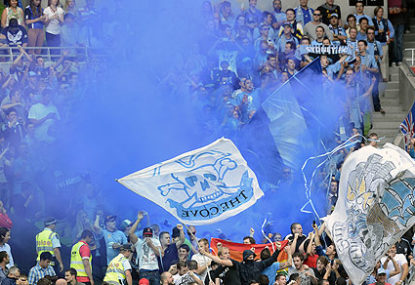For nearly ten years, the clubs of the former National Soccer League have been rendered to the backwaters of Australia’s footballing landscape.
Now, it is time for the sport’s national governing body to take a leap of faith and consider accepting some of these clubs back into the mainstream.
Long deemed too ‘ethnic’ and too ‘troublesome’ for the A-League competition, historic and successful clubs – like South Melbourne and Sydney United – have been forced to live out their existence over the past decade battling it out in their respective state leagues.
Yet, surely the time has come for football in this country to step past the misplaced stigma associated with ethnically-aligned clubs.
Do we each possess such a short memory to forget the role these sides played in promoting football in Australia when the mainstream was not interested throughout the latter stages of the 20th century?
Or to forget the huge influence these sides had on developing junior footballers in Australia – many of whom went on to succeed in Europe and, further, to help the Socceroos qualify to our recent World Cups?
Oh, yes, I hear some of you thinking: “But, what about the ‘ethnic’ violence?”
Undoubtedly, there were some unsavoury incidents of fan troubles.
One that immediately springs to mind is the case of the Perth Glory team bus being attacked by furious Melbourne Knights fans following a match in 2001, after Glory striker Bobby Despotovski incited the largely-Croatian supporters by making the three finger victory salute used by Serbian soldiers in the Balkan war.
Though, surely we are kidding ourselves if we think violence is not ever-present in the A-League today.
Splashed across the news just a few months ago was the apparent Melbourne Heart fan who waltzed into a bay of Western Sydney Wanderers fans and king-hit a man.
Then there’s the numerous clashes that have occurred outside Hindmarsh Stadium between fans of Adelaide United and Melbourne Victory over the years.
Sure, the mainstream media tends to blow it way out of proportion, but violence between A-League fans certainly does occur.
More to the point – and shifting away from this perception of crowd troubles – some of these traditional Australian clubs offer a vastly superior alternative to expand the A-League compared to ideas being thrown around at the moment.
Some seem intent on inventing brand new clubs in populated areas such as Geelong and Tasmania, or working on existing clubs in places like Wollongong and Canberra.
Yet, I cannot help but feel convinced some of these sides would be destined to fail.
Geelong is only an hour’s drive from Melbourne, and most who catch the train along that route on a Melbourne Victory matchday would quickly realise the level of support the current A-League side has from that region.
Meanwhile, Tasmania is an unproven arena for major sporting teams. It also presents the problem of whether the side would play out of Launceston in the north, or Hobart in the south.
Wollongong and Canberra seem to be areas that have potential, though the jury is still out on whether they could receive significant backing from the local population.
It is these ‘what ifs’ and ‘maybes’ that make the prospect of re-introducing our former National Soccer League (NSL) clubs a legitimate and enticing one.
Just last month, a crowd of almost 5,000 turned out at Knights Stadium – in the backstreets of Sunshine – to witness the ‘old derby’ clash between modern day Victorian Premier League outfits Melbourne Knights and South Melbourne. (There was no crowd trouble whatsoever on the evening, by the way.)
Imagine the crowd that would have been pulled if this was not a state competition but a national competition.
The interest and support for these clubs is still around, just waiting to be galvanised.
On top of this, some clubs have continued to strive and enjoy success on the football pitch despite their demotion to the lower rungs of domestic football.
Recently, Sydney United claimed the inaugural National Premier League Championship with a 2-0 win over South Hobart.
Certainly, the planned introduction of the FFA Cup next year will serve as an arena for these sides to prove their worth when it comes to featuring in Australia’s national domestic competition again.
While not all former NSL heavyweights should be immediately considered for entrance into the A-League, some clubs, particularly South Melbourne, have proven their ambition and readiness.
Therefore, it would be ignorant and remiss of the FFA to not sit up and take notice of those knocking on the door.
Australian football has much to gain if expansion is undertaken in the right way.
Let’s not continue ignoring our historic clubs until they inevitably disappear into the sporting abyss.





























































































